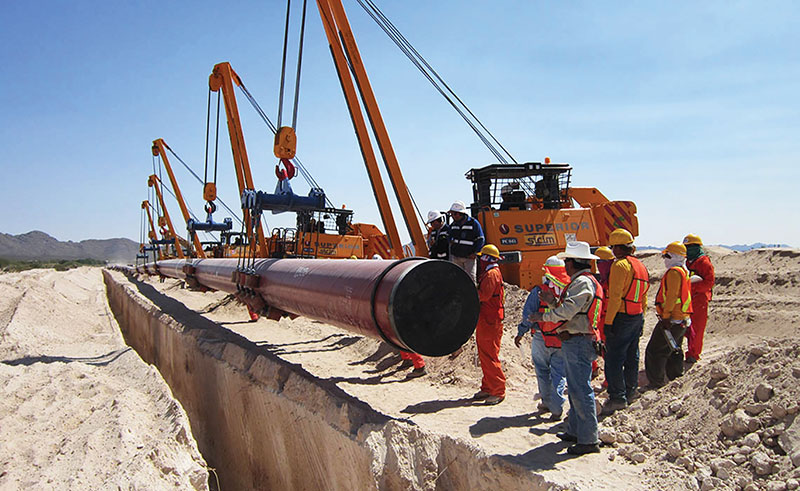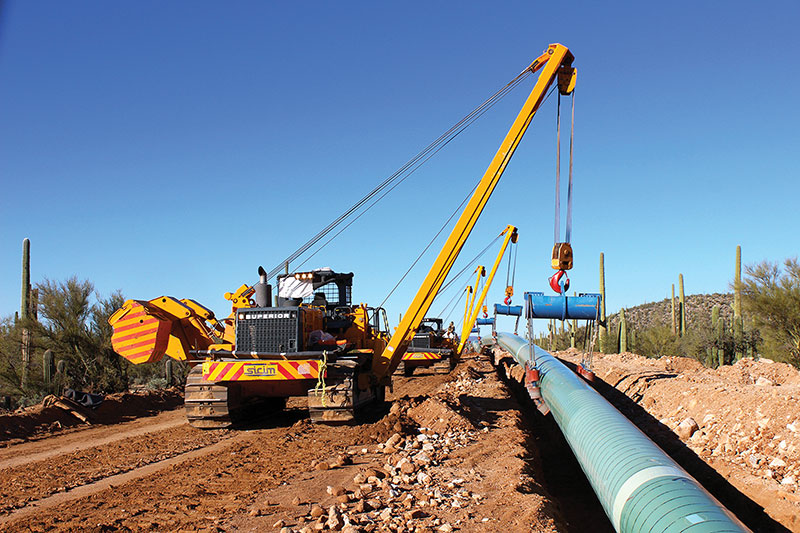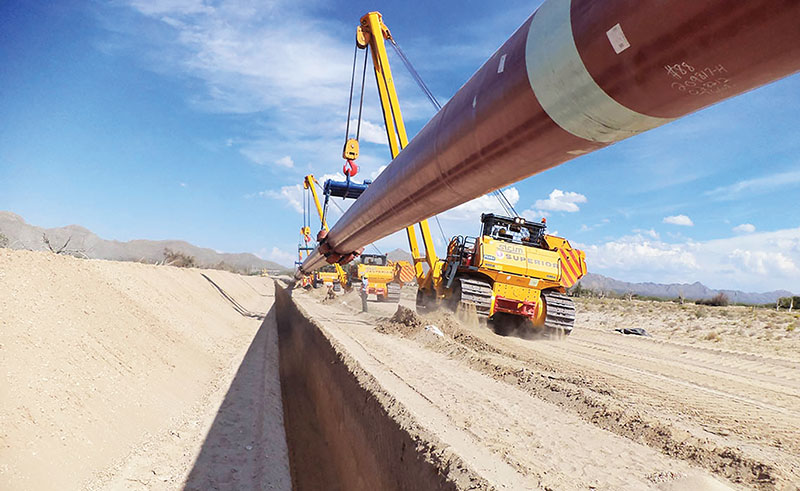August 2020, Vol. 247, No. 8
Features
Mexico’s Endless Pipeline Possibilities, Frequent Disappointments
By Richard Nemec, Contributing Editor
On the last Friday of June, John Padilla, managing director of IPD Latin America, an energy consultant focused on Mexico and Columbia and living in an upscale part of Mexico City, found himself more unsettled and perplexed.
Minister of Security Omar Garcia Harfuch had been shot three times and three others were killed in a vicious attack by members of the Jalisco Nueva Generacion cartel on the Reforma in Padilla’s neighborhood.
Separately, later that morning, President Andres Manuel López-Obrador alleged that an energy chapter important to Mexico was omitted in the new North American Free Trade Agreement (NAFTA) with the United States and Canada, USMCA, that was effective five days later (July 1).
“Unprecedented times to say the least,” Padilla said at the time. “We can expect substantial international litigation and pressure from even further U.S. interests once the USMCA kicks in; this is truly the calm before the storm.”
Padilla and other candid observers of the Mexican energy sector were nearly unanimous in saying market confidence has been badly broken south of the U.S. border, but the judicial system in Mexico remains a beacon of hope.
“The Supreme Court is what to watch in the rest of 2020 as certain cases inevitably end up there,” said one long-time participant in Mexico’s energy affairs.
Those who can muster optimistic outlooks tend to emphasize a long-term view, keeping a close eye on Mexico’s many free trade agreements, and speculate on how long the federal government will continue to prop up the national oil company, Petroleos Mexicanos (Pemex).
Historically and statistically, the diversity of Mexico can surprise most norteamericanos; it is the world’s 14th-largest nation, 11th by population with the 12th-largest economy by GDP (PPP) (gross domestic product based on purchasing power parity) and the second-largest in Latin America. Under the shiny surface of the numbers, however, reality tends to be more complicated.
At ground level, the story is harsher with a large disparity between rich and poor, high functional illiteracy rates (29%) and high under-employment (28%). In short, Mexico is a diverse country, and a broad analytical view is advised when interpreting any statistics used in this report. Mexico is ranked as the world’s seventh-biggest oil producer, and this is reflected in its energy mix.
In the last two decades, gas has steadily substituted for fuel oil and coal (imported from the U.S.) for electricity generation, but the demand for gasoline driven by the transport sector has increased nearly 50% in the last 10 years and is likely to continue doing so.
Even nine years ago, the share of “clean energies” (the term used by Mexican regulators to include large hydro and nuclear) was 20%, and the annual growth rate of 1.1% for these sources lies still below the 2.4% for the total installed capacity. Nuclear and wind energy are the main potential sources considered in the scenarios for 2026.
In the spring of this year, even if the raging pandemic and the anemic global energy markets were set aside, there were plenty of physical and political barriers against regaining any past momentum in Mexico’s energy operations. Nevertheless, gas imports from the United States only fell by about 10% year-over-year in May, and have since begun to rise, according to Genscape Inc., and imports have surpassed 5.1 Bcf/d (144 million m3/d) on average the first half of June.
Developments in Mexico were increasingly linked to Waha Hub prices and the restart of production in the Permian Basin. Energy sector observers and pundits alike were predicting positive movement in both the hub and basin coming when gas begins flowing on the 886-MMcf/d (25 million-m3/d) final section of Fermaca’s Waha-to-Guadalajara, or Wahalajara system, which will bring Permian gas to Guadalajara in the industrial heart of Mexico’s central-western Bajío region.
U.S. trade press reported in late spring that the final new pipeline section known as Villa de Reyes-Aguascalientes-Guadalajara was physically completed in late March, but gas had not begun flowing amid regulatory and other issues, while the coronavirus lockdown was slowing permitting in general.

As activity picked up in late June, Mexico’s upstream regulator for exploration and production (E&P), Comision Nacional de Hidrocarburos (CNH), approved Pantera Exploracion y Produccion to drill two wells south of the Texas border in the Burgos Basin, including a $6.37 million investment in one of the wells.
While pessimism seems rampant in this year of plague and market turmoil, some of the numbers were turning positive as the northern globe passed its summer’s solstice. Before July, exports to Mexico jumped 11% in May, averaging 5.2 Bcf/d (147 million m3/d). “U.S. natural gas exports to Mexico are up sharply this month amid signs of looming demand growth from warming temperatures, a reopening economy and from Fermaca’s delayed Wahalajara pipeline system,” S&P Global Platts data showed at the time.
What S&P called “surging southbound exports” came amid an uptick in gas demand from Mexico. Month-to-date total demand has climbed about 300 MMcf/d (8.5 million m3/d) to an average 7.9 Bcf/d (224 million m3/d) as more summer-like temperatures arrive, driving additional cooling load from Mexico’s power generators.
In mid-June, an analysis from Johns Hopkins University called out Mexico as one of 15 nations, including the United States, with COVID-19 cases trending upward. Separately, the International Monetary Fund predicted Mexico’s economy would shrink by 10.5% this year.
In this backdrop, Mexican government officials, including López-Obrador, were reporting that Spanish power giant Iberdrola was canceling its $1.2 billion gas-fired combined-cycle power plant at the port city of Tuxpan, which is the final destination for an under-the-Gulf-of-Mexico (GOM) gas pipeline from Texas.
“Latin America is absolutely ground zero now for the coronavirus; and the numbers are going through the roof,” Padilla said. “Mexico is about ready to surpass Spain in terms of reported deaths, and that is despite many reports of tremendous under-reporting in Mexico, particularly Mexico City.”
When the Permian was going great and there was had no pandemic, and even with the pullback from the virus and global price situations, everyone thought the offtake projects were going to continue, but Padilla thinks that still has not fully materialized.
Meanwhile, the growing confrontations between the López-Obrador government and the private energy sector was causing national U.S. and international organizations to raise alarms. Separately, in June, the American Petroleum Institute (API) and the American Fuel & Petrochemical Manufacturers (AFPM) wrote letters to the Trump administration asking for help in Mexico.
At about that same time, the International Energy Agency (IEA) and IMF published a special report on “sustainable recovery” from the pandemic and sluggish economy, outlining a road to recovery through a series of targeted investments from 2021 through 2023.
It is clear that the newly effective USMCA holds substantial interest on both sides of the border; although, officials and industry practitioners may have different expectations now that it became the working replacement for NAFTA. “Free trade” is still a key to the document, even though it was omitted in the trade pact’s title.
In late summer, industry leaders were expected to have a clearer idea of what the short-term future might be like in Mexico. Ahead of its effectiveness July 1, major U.S. energy organizations aired questions and concerns on USMCA with the Trump administration.
API CEO Michael Sommers raised concerns in his letter about actions in the spring by the Mexican government that he thinks “undermine [the USMCA] framework and discriminate against U.S. investors in violation of commitments that Mexico agreed to in both NAFTA and USMCA.”
Sommers cited Mexican regulatory actions that were “inconsistently applied or inconsistent with past practice.” He told Trump administration cabinet officials that U.S. investors are facing increasing difficulties getting permits for retail, infrastructure and the import of fuels.
“For the energy sector, North American free trade is critical,” according to Chet Thompson, CEO at AFPM, noting that Canada and Mexico account for more than half of U.S. crude oil imports. “They also are two of the most critical markets for U.S. exports of refined products, such as gasoline and diesel. Mexico is the largest export market for the United States, and last year we sent 1.2 MMbpd of refined products there, more than triple the volume of just a decade ago.”
Thompson said that recent actions by the Mexican government “threaten the important progress that has been made,” adding that media reports in late June indicated Mexico’s leaders had taken multiple actions aimed at restricting ongoing and future U.S. investments in the Mexican energy markets. API’s Sommers urged the U.S. government to use diplomatic channels to intercede with López-Obrador and U.S. cabinet-level counterparts in Mexico to urge them to uphold Mexico’s USMCA commitments “to treat U.S. investors and exporters fairly.”
“Today, there is an increasingly confrontational posture by the Mexican government toward private companies and private investment,” said Jeremy Martin, vice president for Energy and Sustainability at the LaJolla, Calif.-based Institute for the Americas. “We’re actually seeing pushback because of USMCA pressure being exerted by U.S. trade associations on behalf of their members with investments or an interest in investing in Mexico. That includes API and the petrochemical association because they feel they’re being pinched by the government in Mexico.”
Martin thinks USMCA is extremely important. Even though it cannot drive policy in each country, it can help protect foreign investors by formalizing the terms of commercial relationships among the three nations. “It allows there to be leverage for private investors,” Martin notes. “It is an important protection for each individual nation’s economy.”
API’s Stephen Comstock, vice president Corporate Policy, thinks the continued existence of a new NAFTA under USMCA will be positive. “We had a strong case under NAFTA, and we should continue that under USMCA. I don’t see any reason for that to stop,” he said. “It facilitates Mexico’s energy needs and facilitates a solid export market for the United Sates.”
In the national capital, Consultant John Padilla said Mexico is certainly still very relevant for the United States, but in 2020 there is a lot of uncertainty in terms of policy direction. When USMCA became effective July 1, López-Obrador also celebrated his second anniversary as president with four more years in his six-year office term. Future policy direction is something U.S. officials and businesses need to monitor closely, he said.
While the López-Obrador administration favors monopolies and continues to prop up Pemex, Padilla thinks what happens on the legal side in the courts will dictate a lot regarding the future of more private energy investment. He thinks the current administration has a tremendous market opportunity with energy, “but it lacks the capacity and structure to build upon it.” Some of the legal action may be between Mexican federal agencies like the late June lawsuit filed at Mexico’s Supreme Court by the Mexican government’s antitrust regulator, the Federal Economic Competition Commission (Cofece), against the federal energy ministry over some electricity policy that allegedly was driving a wedge between the government and foreign allies.
In reaction, Mexico’s Supreme Court suspended new power sector rules imposed by the energy ministry, marking a rare victory for proponents of competition in the country’s energy industry, according to Mexican analysts. Sener’s rules, dubbed the Policy of Reliability, Safety, Continuity and Quality in the national electric system, halted pre-operative tests for renewable energy plants, preventing their operation. It also mandated that certain power plants owned by state utility Comisión Federal de Electricidad (CFE) be given priority in the dispatch order ahead of private sector generators, irrespective of production costs.
Sener defended the rules as being needed to ensure stable grid operations in the wake of COVID-19’s impact on power demand, a justification that was questioned by energy sector stakeholders. The unilateral rule change provoked multiple legal challenges, including one filed by antitrust watchdog Cofece. Ultimately, the high court agreed to hear the case, and to suspend the new rules in the meantime.
In Mexico’s regulatory circles, Padilla and other analysts point to efforts in the López-Obrador administration to consolidate the alphabet soup of federal agencies covering energy. In late June, López-Obrador’s administration fired another 200 CRE workers who helped regulate midstream and downstream businesses.
Richard Nemec is P&GJ’s contributing editor based in Los Angeles. He can be reached at rnemec@ca.rr.com.







Comments